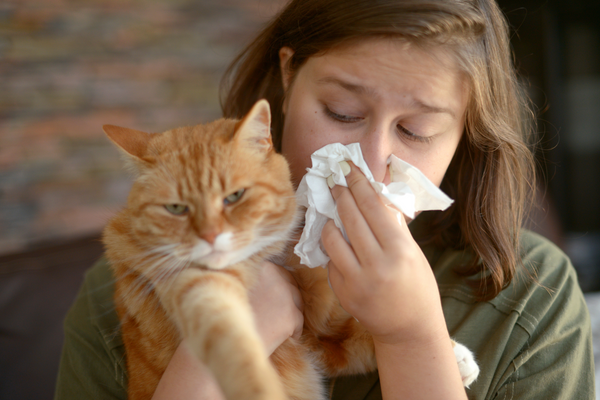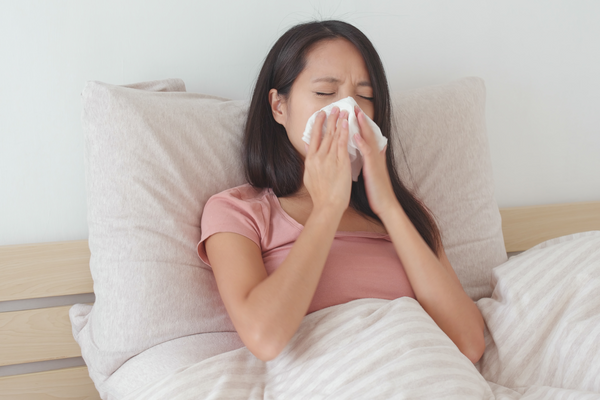Why Are So Many People Allergic to Cats?

To the frustration of feline fanatics everywhere, allergies to cats are incredibly common, especially among people who have other allergies or asthma. In the United States, as many as three in 10 people with allergies have allergic reactions to cats and dogs. According to the American College of Allergy, Asthma, and Immunology (ACAAI), cat allergies are about twice as common as dog allergies.
Among children, about one in seven between ages six and 19 prove to be allergic to cats.
Read on to find out why cat allergies are so common and learn about some proven ways to reduce cat allergens––and the symptoms that come along with them.
Cat Allergy Symptoms
Symptoms of cat allergies are not tough to miss. They tend to happen whenever there’s a cat nearby or when an allergy-sufferer has encountered some lingering cat hair on (or under) furniture. However, according to the Asthma and Allergy Foundation of America (AAFA), symptoms may not appear until after several days of contact with the pet if allergen levels are low or sensitivity is minor. The AAFA also notes that contact with a cat can trigger a severe asthma episode (asthma attack) in up to three in ten people with asthma. Cat allergies also can lead to chronic asthma.
Some typical cat allergy symptoms include:
- Sneezing
- Coughing
- Wheezing
- Nasal congestion
- Runny nose
- Itchy, red, watery eyes
- Skin redness, eczema, and rashes
- Chest tightness
In extreme cat allergy cases, a severe reaction can occur, known as anaphylaxis, in which the allergic individual may experience itching, hives, swelling, respiratory distress, shock, or even death. In general, symptoms will worsen when an allergy sufferer is exposed to more significant amounts of allergens or when several different types are present. Therefore, reducing exposure to allergens can reduce the severity of the symptoms (we’ll elaborate more on this below).
Although anyone can develop allergies at any time, some families are more prone to them. And while individuals do not inherit an allergy to a specific allergen, the overall likelihood of developing allergies is increased when other family members have allergies.
What Causes Cat Allergies – And Why Are They So Common?
Contrary to popular belief, your beloved cat’s fur is not the reason you are allergic. Though your cat’s gorgeous coat can be instrumental in the transmission of the triggers that are causing your allergy symptoms to flare, it’s not the fur itself that your immune system is rejecting. Rather, people with cat allergies are allergic to proteins in a cat’s saliva, urine, and dander (AKA shed skin cells). Additionally, cats, along with other animals with fur, are also more likely to carry allergens from other sources, like dust.
Cat dander is a particular problem because it is so tiny (microscopic, in fact) and can remain airborne for long periods with the slightest bit of air circulation, causing them to land on surfaces like furniture or clothing and also making them easy for allergic humans to inhale. The allergens can also be deposited on the cat's fur through licking. Once the hair dries, the particles can flake off, and the allergen becomes airborne. So, that means your beloved feline can spread her dander all over your home when she grooms herself, chases a favorite toy, rolls around on the sofa, and all the other ways she lives a delightful cat life.
When you experience the symptoms of your cat allergy, your hypersensitive immune system responds to these otherwise harmless proteins as if they were dangerous foreign bodies (like a virus or bacteria, for example) and is attempting to flush them from your system. This is why you experience those awful symptoms after being around a cat.
The Myth of the Hypoallergenic Cat
Unfortunately, there are no truly hypoallergenic cat breeds. That said, the number of allergens produced can vary significantly between individual cats, and people may react more severely to one particular cat over another. Keep in mind that these differences in allergen production are not related to the hair length or breed of the cat. Even hairless breeds, like Sphynx cats, can cause allergic reactions in allergy sufferers. However, there is evidence that unneutered male cats produce more allergens and that these levels decrease after neutering. This is yet another excellent reason to make sure to have your cat spayed or neutered!
The bottom line: since all cats produce at least one type of allergen, hypoallergenic (AKA low allergen-producing cats) and allergen-free cats do not exist.
How to Reduce & Prevent Cat Allergies
Fortunately, if you have cat allergies, you can take steps to reduce symptoms. Avoiding contact with cats is one option, though not realistic for many people! Keep in mind that even after a cat is taken out of a house, allergen levels can remain high for up to six months unless proper steps are taken. However, decreasing the number of allergens in your home can dramatically reduce allergy symptoms in cat allergy-sufferers.
Remember that best results in reducing allergens are found when the recommendations listed below are applied consistently over time. In all cases, talking with your doctor or allergist is highly recommended, as some people may benefit from prescription medication, allergy immunotherapy, or other medical treatments.
- Bathe cats regularly (weekly, if possible) with The Ecology Works Anti-Allergen Pet Shampoo to remove allergens from their fur. Our Anti-Allergen Pet Shampoo neutralizes allergens from pet dander on contact while cleaning and conditioning for an extra-soft, fresh-smelling coat. The 100% biodegradable plant and mineral-based formula also makes our pet shampoo an Earth-friendly choice.
- Eliminate decorative scented candles, air fresheners, and fragranced cleaning products, all of which exacerbate allergy symptoms.
- Limit cats’ access to the bedrooms of allergic people. Airborne cat allergen levels have been found to be much higher in rooms where cats are physically present.
- Avoid “dry” cleaning (brooms and feather dusters), which can cause common allergens, including cat dander and dust mites, to go airborne. Instead, always clean with wet supplies such as damp microfiber cloths and mops, which will trap and remove allergens. Adding the The Ecology Works Anti-Allergen Solution to your dusting routine will neutralize allergens from cat dander on contact. Our Anti-Allergen Solution is hypoallergenic, made with a plant and mineral-based solution. It’s free of fragrances and other ingredients that can worsen allergic reactions. The 100% biodegradable formula is also safer for the planet, so you can feel good about spraying it liberally.
- Clear away clutter. Less stuff around the home makes it easier to clean and get rid of pet dander.
- Vacuum regularly carpets, rugs, upholstery, and pet beds a few times a week with a vacuum cleaner that is equipped with a HEPA filter to prevent the outflow of the contents (including cat allergens) that have been swept up.
- After thoroughly vacuuming, apply The Ecology Works Anti-Allergen Solution to carpets, rugs, upholstery, pet beds, and more to neutralize cat dander (along with other common indoor allergens) on contact.
- In addition to using a HEPA filter in household heating and cooling systems, the use of an air purifier with a HEPA filter in the room where pets spend most of their time will reduce the concentration of allergens floating in the air.
- When laundering bedding, clothing, rugs, and other washable items (including pet beds), use an Anti-Allergen Laundry Detergent to provide relief for allergy sufferers. Our Anti-Allergen Laundry Detergent removes allergens such as dust mite waste, mold, mildew, smoke, pollen, and pet dander on all types of clothing and bedding. This 100% biodegradable plant and mineral-based formula naturally removes the allergen while leaving your washables fresh, clean, and soft.
Have questions about reducing allergens inside your home? We have answers! The Ecology Works has been helping folks with asthma and allergies since 1993. We can help you select the products you need to live a better, allergen-free life. Check out our Instagram for more allergen-reducing tips. Need more help? Please feel free to Contact Us or message us on Facebook. No question is too small! We're here to help.




